Why Scientists Need Artists: The Benefits of Collaborative Creativity
By James Day
The following long-form article was produced by Ars Scientia Program Manager and Blusson QMI Senior Research Associate Dr. James Day, as part of the Ars Scientia-inspired creative writing course Storytelling, Persuasion, and Physics at UBC.
When Bongos Met Brushes
There is a famous anecdote about a renowned scientist. The telling begins in the late 1950s, with a party that was in full swing. The room was alive with energy, as people chatted, danced, and drank to the sounds of rock and roll and jazz. Women wore poodle skirts, saddle shoes, and bright lipstick, while men sported slim-cut suits and fedoras. Guests shared their views on current events, politics, and popular culture amid the smoke and chatter.
Suddenly, the beat changed, and a small group gathered around future Nobel Prize-winning physicist Richard Feynman, playing the bongo drums with intricate rhythms. As Feynman played, artist Jirayr Zorthian was inspired to transform himself into a living canvas, smearing shaving cream across his chest in wild designs. This spontaneous act led to an intimate conversation between the two, where they vowed to share and teach each other their respective crafts. Over time, Feynman found himself diving into art, grasping the nuances of drawing from Zorthian, while Zorthian ventured into the abstract world of quantum mechanics.
Their collaboration went beyond casual exchange. Feynman's sketches, influenced by Zorthian, showcased a developing understanding of form and movement. Zorthian's practice began reflecting hints of quantum-inspired patterns. It wasn't just about combining two fields; it was about how they infused and transformed each other.
This union of art and science is more than an entertaining tale: it set a precedent. Their experimental blending of worlds became an archetype for subsequent collaborations. Unions between scientists and artists have persisted into the present era. Through personal involvement I know that the results, while perhaps less renowned, carry the same potential for brilliance and innovation, challenging and reshaping our perceptions of what's achievable when worlds converge.
Beyond the Canvas and the Lab
I first came across this anecdote as a high school physics student, engrossed in the pages of "Surely You're Joking, Mr. Feynman!", a renowned science book of its time. Feynman had a knack for delivering memorable phrases. At that time, I paid little attention to any particular aphorism or story, yet his overall quotability left a lasting impression on me. His ability to encapsulate profound truths with such casual language and tone was, and still is, remarkably impressive. In recent years Feynman’s relationship with Zorthian has loomed in importance to me as I’ve become involved in a program called Ars Scientia, which embodies the excitement of what those two found possible in collaboration. Merging the practices of art and science in the growing field of interdisciplinary research, Ars Scientia is a research partnership at the University of British Columbia (UBC) between the Blusson Quantum Matter Institute (Blusson QMI), the Department of Physics and Astronomy, and The Morris and Helen Belkin Art Gallery.
Despite the geographical separation between the Ars Scientia team, with my physics colleagues and I situated in the south and the gallery group in the north, the Main Mall that bisects the campus serves as a symbolic representation of our project's aim. It embodies our intention to unite these seemingly disparate parts, creating a cohesive whole from the different elements. As a core practice on a university campus, Ars Scientia is a special example of science and art interacting.
In the wake of Zorthian and Feynman, others have embarked on similar journeys. Collaborations between artists and scientists have become increasingly popular as both fields recognize the benefits of working together to generate innovative ideas and advance knowledge. Several institutions, including The Museum of Modern Art and the New York University Neuroscience Institute, The University of California, Berkeley Art Museum and Pacific Film Archive, and The National Institutes of Health and the John F. Kennedy Center for the Performing Arts, have recently organized exhibitions and projects that explore the intersection of art, science, and technology, featuring works by artists, architects, and scientists. These collaborative initiatives encourage visitors to engage with scientific concepts and explore the relationship between art, science, and the natural world.
Inspired by Feynman and Zorthian, it is not controversial to state that collaboration between artists and scientists can be generally beneficial. They can bring unique perspectives to scientific research and artistic expression, encourage interdisciplinary thinking, and enhance communication and outreach, ultimately leading to more innovative and impactful discoveries and output.
A Physicist’s Front Row View
Backed by threads of literature and being uniquely positioned as a research physicist at the Blusson QMI and the project coordinator for Ars Scientia, I think a more substantial claim can be made. My role has required me to develop a personal relationship with all the artists and scientists in these collaborations. As a result of my duty, I have been given a front-row seat to an interactive show that allows me to dialogue with the participants. My assignment permits me to ask questions such as "What has been challenging?" and "How has the other influenced you?" and "What have you learned?"
Since its conception, Ars Scientia has aimed to promote interdisciplinary exchange between the arts, sciences, and education, by employing a methodology of genuine, non-transactional, and process-oriented collaboration. By genuine, I mean that collaboration is based on a true desire to work together and achieve the common goal of interdisciplinary exchange. By non-transactional, I mean there is no focus on the exchange of services. Process-oriented means that the priority is not on achieving an end result but on the methods used to achieve it. Rather than emphasize content creation and results from a partnership, the goal of Ars Scientia is to shift thinking and reframe familiar concepts to spur creativity and open doors to unfamiliar spaces.
The Colour of Quantum: A Tale of Art, Science, and Unexpected Beauty
One example of these Ars Scientia partnerships is that of artist jg mair and Blusson QMI material scientist Dr. Alannah Hallas: the Quantum Materials Paintings. This collaboration has resulted in a brilliant art breakthrough and a surprising but soft, intangible alteration of a researcher's mindset.
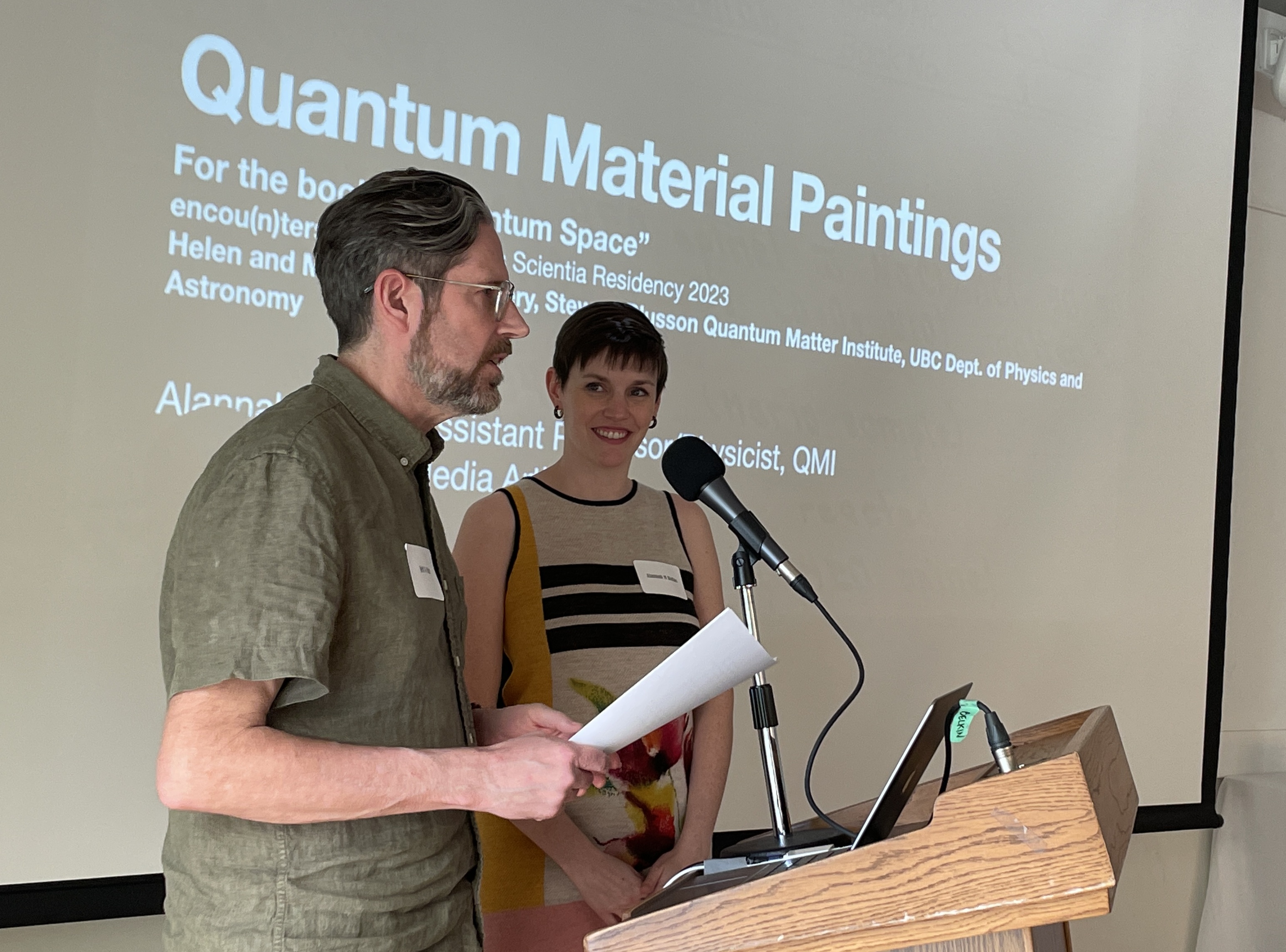
As one enters the Hallas Crystal Growth Lab at the Blusson QMI, one is immediately struck by the vivid display of physics and chemistry in action. A periodic table of the elements hangs on the wall like a tapestry of discovery. At the same time, workbenches in the middle of the room are replete with logbooks of synthesis recipes, glass vials of elemental ingredients, and sets of mortars and pestles ready to grind them down.
The lab's perimeter is lined with tube and box furnaces glowing from the heat of creation, hydraulic presses compressing the very elements of nature, and fume hoods whisking away the chemical dance. In one corner is parked a Laue x-ray diffractometer, used to study the atomic structure of materials grown in-house, humming with anticipation. In an adjacent room and concealing an inferno of heat, two image furnaces (one of which is pictured below) dazzle with their operation, reaching temperatures as high as an astonishing 2500 °C. In these, the latest high-entropy oxide (HEO) materials were being developed, each crystal a triumph over what mother nature had not done.
HEOs are materials with configurational disorder due to multiple elements in a single lattice. They offer unique properties which can be synergistically enhanced, leading to potential applications in energy storage, catalysis, and electronic devices. Researchers study HEOs to create new materials with superior properties and combine elements for more remarkable results.
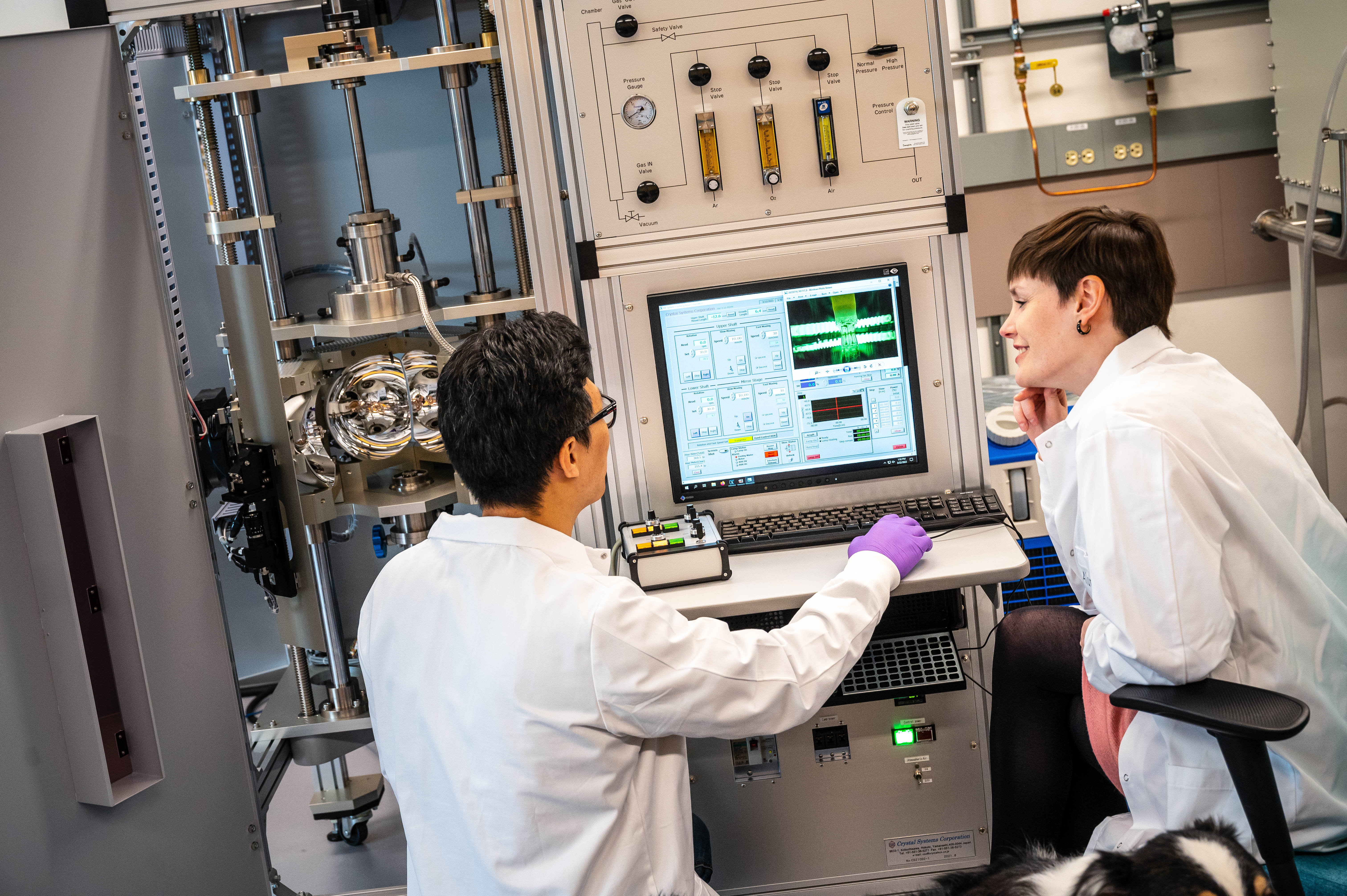
Upon his first visit to the lab, Hallas described to mair the process of making these materials and physically handling them, explaining that they are macroscopic in scale.
"I don't think he imagined that the materials we were working with were things that you can just pick up and hold and see," Hallas explained.
This intrigued mair; after all, wouldn't quantum materials be on the nanoscale and, therefore, not visible to the naked eye?
"And then we start talking about appearance and colour," Hallas continued, "and how colours are very intimately connected to the electronic properties of a material."
mair asked if these materials could be used as pigments, a question that Hallas had never before considered.
"This idea of pigments came around, and we talked about how much of the history of painting has been in parallel with improvements in the availability of colours or stable pigments," Hallas explained. "For a long time, there were not many great options for blues. The blues were really difficult shades, which is why you don't see many of them early on."
Indeed, blue pigments became increasingly rare and costly during the Middle Ages, leading to their exclusive use by the wealthiest patrons. However, in the Renaissance period, there was a resurgence of blue in art thanks to the introduction of new, affordable pigments such as Prussian Blue and Cobalt Blue.
"There has long been a parallel track with art and chemistry," continued Hallas. "I very much like the sense of connection to historical chemistry and of rediscovering this aspect. Some of the [pioneering] chemists were artists because they were experimenting with different chemicals that could be used for pigments. People were doing all sorts of [wild] things to try to get the perfect red or perfect white."
Both mair and Hallas found the idea of turning HEOs into a paint pigment intriguing because those same materials would be utterly unique in the world. "Although other labs may have made the same material," Hallas clarified, "their process would be different, resulting in different levels of impurities and environmental conditions. There is a tangible sense that the material was made with our hands and our specific recombination process."
Hallas had classified the HEO samples contributed to this project as scientific failures, instances where something had slightly gone awry during their growth. Had they held experimental value, they would have been far too valuable to squander on paint. The creation of experimental materials is a costly endeavor, not only financially, but also in terms of time and intellectual effort. Even the failures embody a significant amount of work, a fact that is reflected in the unique character of these paints.
And so mair eventually broke out a matrix: a transparent polymer, used to mix pigments into paints. Hallas admitted that the mixing "was anticlimactic in the sense that it didn't explode but climactic in the sense that once it was mixed into this matrix, you could really see the colour."
One could see the colour of the HEO powder before mixing, but Hallas revealed, "when you're looking at the powder, a lot of what you're seeing is also the morphology: the shadows of the grains and the surface is sometimes a slightly different colour due to oxidation than the interior."
She then said that "once it was dissolved in the matrix, it was a very uniform colour." and marvelled, "It was beautiful."
mair endorsed, "I was surprised with the results: I did not expect the high-entropy oxide paints to be so rich in colour and texture."
The Quantum Materials Paintings 2-7 have emerged from this process. They belong to the "High Entropy" series, featuring laboratory-created quantum materials blended with a transparent acrylic medium. Each painting is displayed on its own 8" x 8" x 1.5" panel. And they are beautiful: each painting has depth and brilliance, with quantum materials revealing unexpected hues beneath the acrylic's surface.
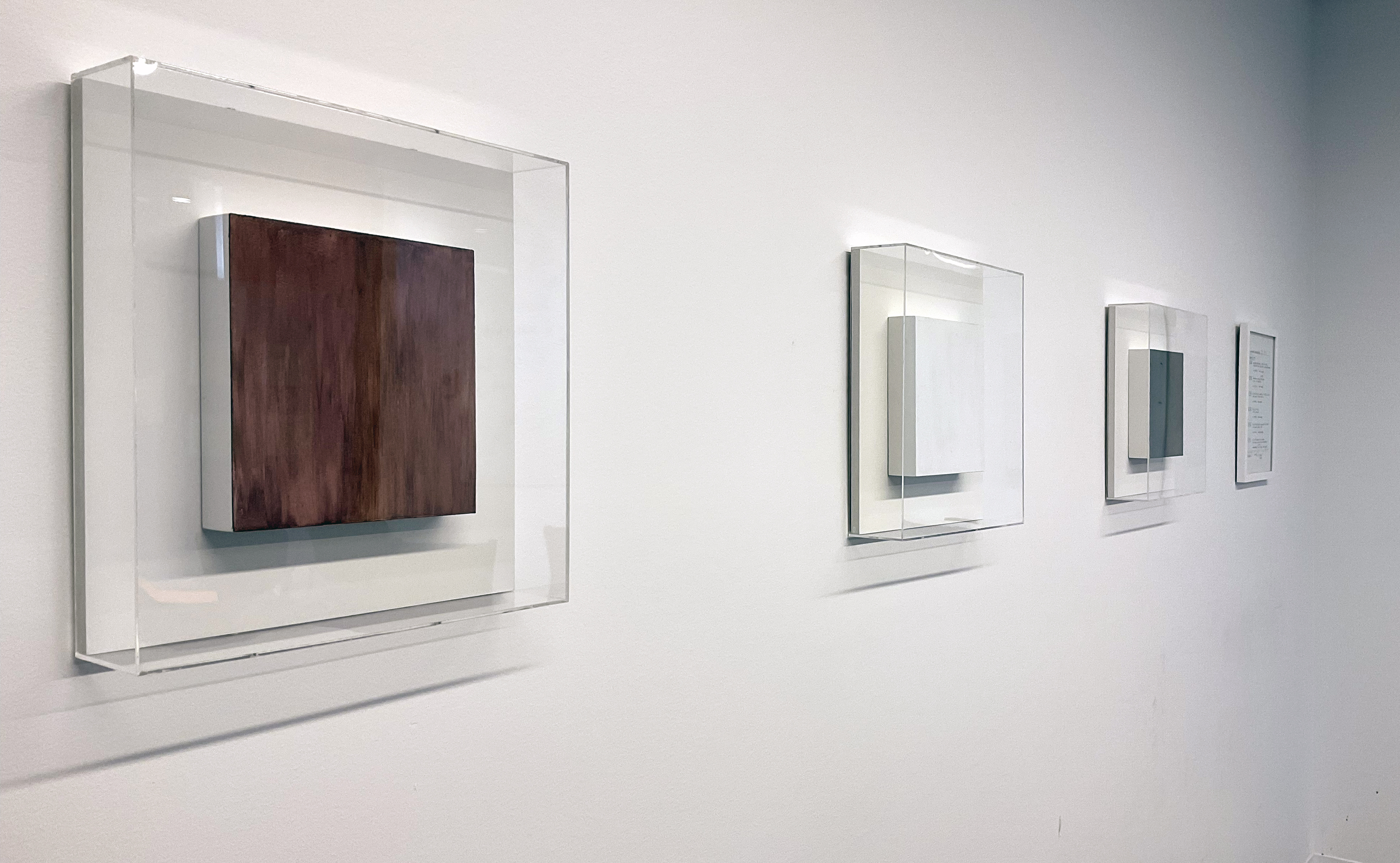
mair expressed that this collaboration's output has "the potential to engage a new audience. Before this collaboration, I had no idea what quantum matter was, let alone what it looked like. As an artist, I'm always searching for ways to create dialogue and ask questions. I would say that is also a goal of science. With the paintings, I think we created something novel that I hope could bridge some gaps."
mair emphasized that he wanted the Hallas group to select the materials to be featured, allowing the significance to originate from them due to their intimate connection with these materials. After all, they had a direct role in their creation. As previously noted, these pigments are unique in the world. And in some cases, Hallas wistfully considers, "they're unique because they were kind of failures: they were growths that didn't work out. So, to us, the material was dead. But now it's living this whole new life as a pigment, and that for me… it was just completely romantic."
"Perhaps my main takeaway with the entire experience," mair concluded, "is that I am constantly seeing a confirmation of something I once only intuited, but now I know: it is the outer edges of possibility where most of the good stuff happens."
Hallas reflected that the experience gave her "a greater sense of connection to other ways of thinking and to other disciplines that were not the most obvious connections. And I think the way that will change me is that I'm just more open to those sorts of interactions." Meaningfully, she explained that "the project with jeff [mair] felt like a true collaboration. It was the truest collaboration in the sense that I don't think either of us independently could have ever arrived at what the end product has been. There was a lot of mutual respect."
Through The Lens of Collaboration
Hallas’s experience has delivered softer benefits in the form of personal evolution and even greater openness to collaborations. Other examples have led to more concrete research dividends.
Daniel Korchinski, a Ph.D. candidate who partnered with artist Josephine Lee in another Ars Scientia collaboration, admits to an initial, naïve perspective: "I am coming in with the science, I will tell you the science, and you will make an art of it." From this transactional perspective, the artist is not seen as contributing to the intellectual development of the project. Instead, the artist is expected to present the (independently developed) science in an artsy way.
The possibility of finding genuinely collaborative methodologies has significant implications for the University and academy. Real reciprocity, real collaboration, and real interdisciplinary work too often seem to underdeliver. The initial step of finding profound intellectual and academic respect and reciprocity, which is often overlooked, is crucial when collaborating across disciplines and other social boundaries.
Eventually, Lee and Korchinski found their footing. Their collaboration not only led to a beautiful artistic creations but also paved the way for interesting scientific insights.
Lee and Korchinski spent weeks together walking and talking, building trust and exploring shared interests, foretelling the value of discussion and developing a common language. They ultimately focused on a specific ideology of glass: the concept of lenses. And with a mutual curiosity in optical illusions, the two worked towards developing lens and glassworks that could, for example, obscure objects instead of magnifying them.
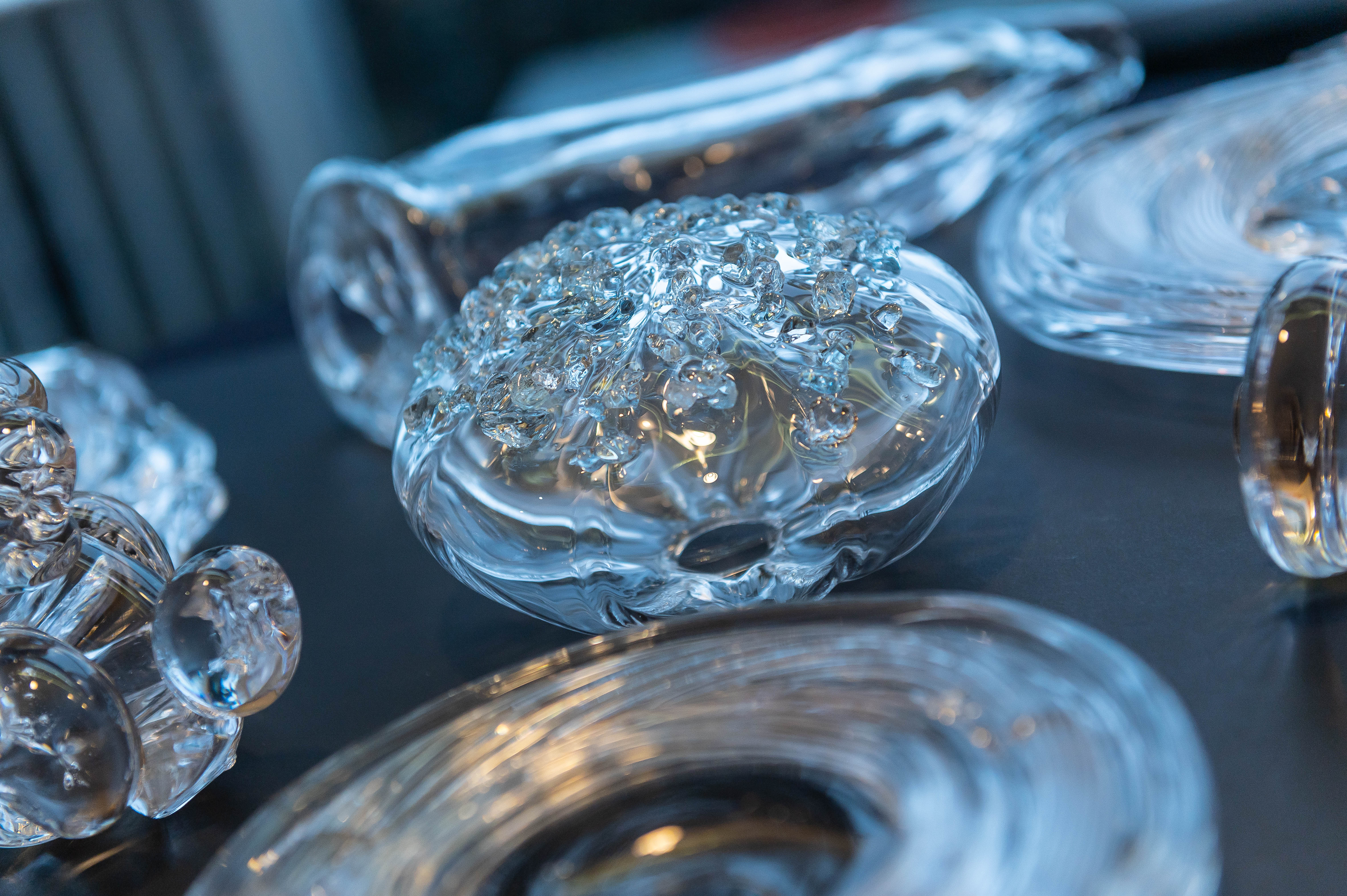
"Optical lenses, in general, have been constructed throughout time to magnify, focus, and clarify the vision," Lee contends. "We have eyeglasses, microscopes, telescopes and all of these sorts of screens that mediate our vision in some way or another. With that visibility comes questions of hyper-visibility, and what control or censorship or violence emerges from hyper-visibility, especially for BIPOC bodies."
Lee's artistic practice has been trying to refuse to be seen in some way. Lee asks questions like: How would it look like to design optical lenses that perform the opposite function of their intended purpose? How can you make a lens that, for all intents and purposes, looks absolutely clear but, by the shaping or configuration of it, would allow the subject to disappear? Can one create obscurity or opacity, or just simply erasure or redaction in some way, to give the hyper-visible the less visible and shield or protect them in that way? And how might a theoretical physicist like Korchinski engage in such questions?
The development of these pieces began as simulations, coded by Korchinski, of light rays passing through materials of varying indices of refraction. With the help of a professional glassblower, Lee and Korchinski worked with glass and explored how they could push the limits of the material. This process generated some feelings of discomfort for the pair.
As a theoretical physicist, Korchinski had limited experience working with his hands; as a student, he felt uncertain about devoting time to a project outside the scope of his thesis studies. As an artist, Lee recognized that she was asking questions about ideological territories Korchinski may have never visited. This project came with a degree of risk, to no one's surprise in retrospect. And both felt, to some extent, that the success or failure of the project rested on their shoulders. (The 6&6 initiative has effectively documented interdisciplinary practice as a venture that carries risks, given its potential to disrupt the established traditions of any given discipline.)
This collaboration has yielded, among other outcomes, an extensive collection of textured and shaped glass pieces. These pieces serve to conceal, veil, and obscure the objects behind them. And they, too, are beautiful.
Korchinski additionally noticed some interesting physics related to the crackling noises heard when their molten glass was cooling. He attributes his observation to Lee's encouragement to experience the glassblowing studio with all his senses. The crackling noises are similar to other natural events, such as earthquakes and forest fires, which are governed by a concept called self-organized criticality. This means that small changes can cause big events, and this type of behaviour is scale-invariant, meaning it happens at different sizes. The noise made during the cooling of molten glass also seems to have this type of behaviour. In other words, the fracturing process in glass is similar to other systems that exhibit self-organized criticality. And, as far as Korchinski knows, this specific phenomenon has yet to be reported in the peer-reviewed literature.
Ink and Insights
Ars Scientia has proven to be transformative for its participants. They now better recognize what it means to develop genuinely collaborative models of knowledge exchange and are better positioned to rethink what it means to disseminate research.
Korchinski said, "I'll tell you one thing: I'm much less afraid to approach people for collaboration. I don't know if I mentioned it, but I'm going on an [work] exchange to Paris for a few months, starting in two weeks. I don't know if I would have had the same confidence to do that [before Ars Scientia].”
As an observer and facilitator of these and other collaborations, I, too, have been changed. I've embraced new behaviours that have opened my eyes to the world around me and adopted a mindset that has made me more receptive to the potential of working with others.
However, it was only through my collaboration, and my immersion in this unique intersection of science and art that I was able to draw personal conclusions about the challenges and potential of these partnerships. I had the opportunity to co-architect and participate in a for-credit, graduate-level course in the Department of Creative Writing with author Timothy Taylor.
The course, titled Storytelling, Persuasion, and Physics, was designed to empower physicists and writers to tell compelling and important stories from the world of science in a popularly accessible way. In the course, we explore the intersection between disciplines, the tools that can be cross-purposed from one discipline to another, and how inspiration can be drawn from examining new practices and research.
Furthermore, we discuss writing approaches with writing practitioners, going beyond the narrative theory that might be offered in more conventional science writing courses. Physics graduate students necessarily know the essentials of their research, but they still need to present them persuasively to others.
My experience has shed light on the nuances of these collaborations and has illuminated the potential for science-side benefits. These partnerships can be structured to provide direct advantages to the scientists involved. Among all the residencies, this one stands unique, being the only one specifically designed with components to deliver dividends solely to the scientists. The attentive reader might suspect that this final example of collaboration is the one that gave birth to this very article itself.
But it's not just my behaviour that has changed – my mindset has also shifted. I'm even more receptive to collaborations, just like Hallas and Korchinski. Instead of focusing solely on outcomes, I'm giving greater weight to the process, which has done wonders for my psychology. I work happier now. And when I work with someone, I prioritize building trust and respect, which I am convinced is crucial for any successful collaboration. I am a better physicist because of Ars Scientia!
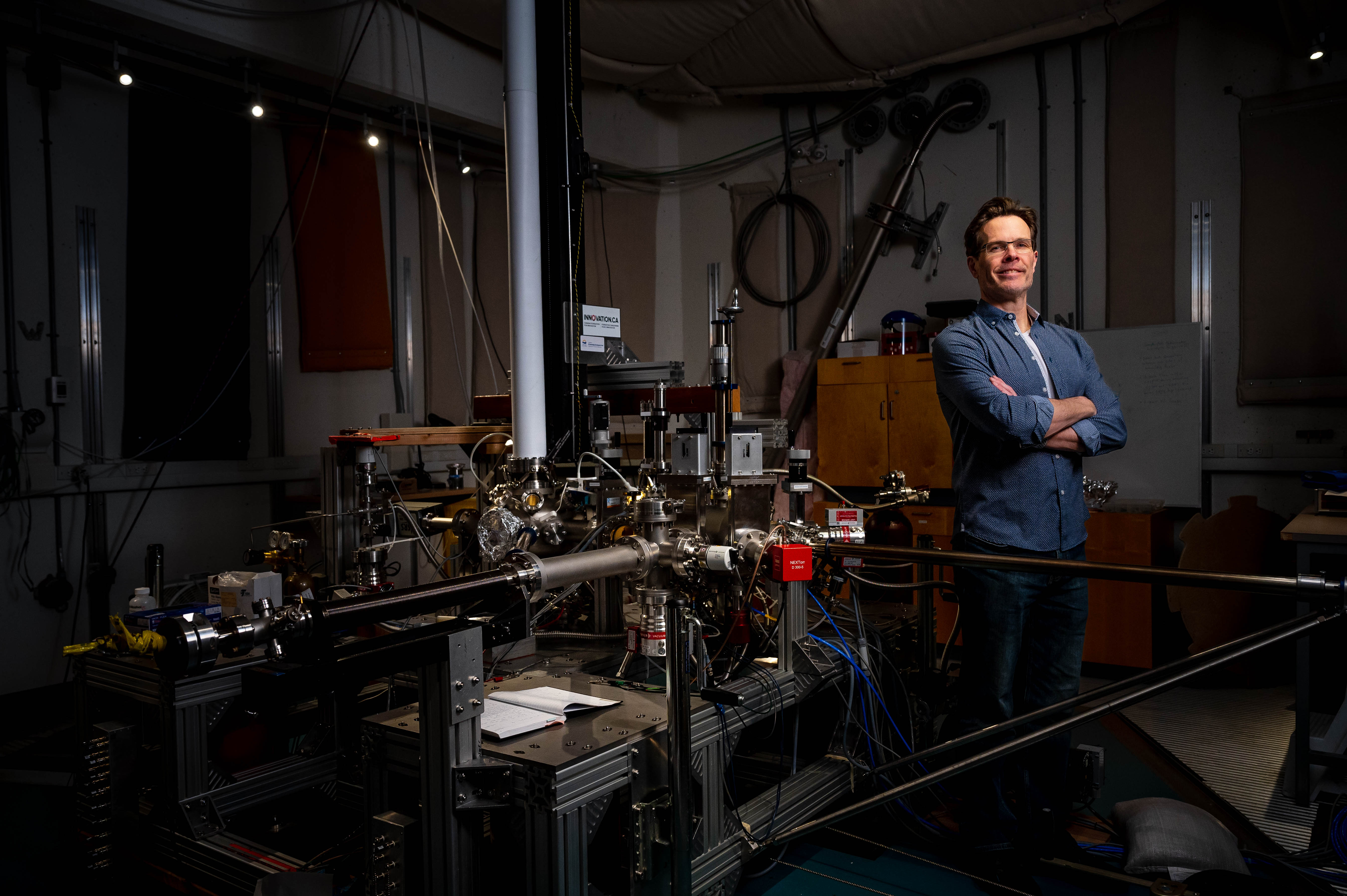
This long-form article was produced by Ars Scientia Program Manager and Blusson QMI Senior Research Associate Dr. James Day, as part of the Ars Scientia-inspired writing course Storytelling, Persuasion, and Physics at UBC.
James has been an instrumental part of Blusson QMI’s community. He supports the High-Temperature Superconductivity (SUPERCON) lab, which uses microwave techniques to probe the electronic properties of unconventional superconductors, and the Laboratory for Atomic Imaging Research (LAIR), which applies scanning probe microscopy tools to develop a deep understanding of new materials.
As Program Manager for Ars Scientia, a transdisciplinary research partnership by Blusson QMI, the Belkin Art Gallery, and the Department of Physics & Astronomy, James has led a nascent residency program linking local artists with UBC physicists to foster new modes of knowledge exchange across the arts, sciences and their pedagogies.
He was awarded an Excellence in Service Award by UBC’s Faculty of Science in 2023 - learn more about James here!
